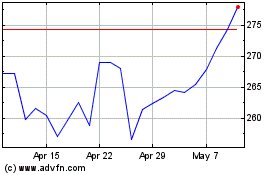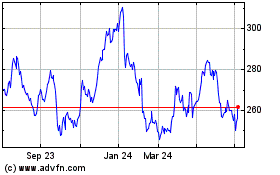Sainsbury Reports Slump in Half-Year Profit--Update
November 11 2015 - 12:44PM
Dow Jones News
By Saabira Chaudhuri
LONDON-- J Sainsbury PLC reported a fall in half-year profit as
the British supermarket chain blamed food-price deflation and
changing customer habits for lower supermarket sales.
Sainsbury's results are strongly indicative of trends that have
been hammering Britain's mainstream grocers for several quarters
now. Customers have been shopping more frequently, in smaller
amounts and across a variety of retailers to get the best bargains,
leaving the country's large supermarkets with fewer customers.
"Whilst people have more money in their pockets, they are not
yet choosing to spend it on groceries," said the company in a
statement, adding that the growth of discounters like Aldi and Lidl
in addition to changing consumer habits has pressured mainstream
supermarkets.
The U.K.'s No. 3 grocer by market share reported a pretax profit
for the six months to Sept. 26 of GBP339 million ($512 million),
compared with a pretax loss of GBP290 million in the same period a
year earlier.
Stripping out one-time items, pretax profit for the first half
totaled GBP308 million, down 18% from GBP375 million a year earlier
but higher than estimates of GBP294 million.
After gaining in early trading, shares plunged following a
conference call the company held with analysts, closing the day
down 7.1%.
"The near-term outlook remains dark," said Exane BNP Paribas
analyst John Kershaw, pointing to Sainsbury's view that deflation
will now last well into the next financial year and its admission
that the discounters have grown faster than expected.
Sainsbury's Chief Executive Mike Coupe on the call said
customers, despite being about GBP20 better off a week than a year
ago, are spending on travel and eating out rather than on
groceries, and that price deflation is about 2%.
Sainsbury and its peers have been battling the march of Aldi and
Lidl by cutting prices to protect market share, but the actions
have eaten into profits.
Ahead of the key Christmas season, Sainsbury is testing new
formats at six supermarkets in an effort to adapt to changing
shopper habits.
The company has reshuffled its store layout to create a
food-to-go section at the front near the checkouts, increased
nonfood space by 30%, and is testing new checkout options. It is
also piloting a shopping app in two stores: After customers scan
their shopping lists, the app shows them a map locating their items
around the store and allows them to pay via smartphone.
Separately, the company is also testing its smallest Sainsbury's
convenience store to date at just under 1,000 square feet. That
store is aimed at working people who quickly want to buy food for
breakfast or lunch or pick up ingredients for dinner.
While sales at Sainsbury's supermarkets declined by over 2%, the
grocer said its convenience stores saw sales growth of close to 11%
while online grocery sales rose by 7%.
Underlying sales excluding value added tax came in at GBP12.41
billion, which is down 1.9% from the GBP12.66 billion reported a
year earlier and slightly below the estimates of analysts polled by
FactSet for GBP12.47 billion.
Like-for-like sales, including VAT and excluding fuel, were down
1.6% for the period.
Sainsbury has been working on striking property deals, building
homes on its properties. Earlier this year the company opened a
refurbished supermarket in London, which increased the size of the
store by 50% while also creating the space to build 463 homes.
Sainsbury said the estimated market value of its properties
declined by GBP300 million during the first half, to GBP10.8
billion.
Sainsbury said cost savings for the first half totaled GBP115
million. It expects full year cost savings of around GBP225 million
and said it remains on track to deliver GBP500 million savings over
the next three years.
The FTSE100-listed company declared an interim dividend of 4
pence a share, down from the 5 pence paid a year ago.
Sainsbury said its clothing line's sales grew by close to 10%
over the half-year, and described growth opportunities for its
nonfood business as "significant." Overall general merchandise
sales climbed by 1.4%.
Tapan Panchal contributed to this article.
Write to Saabira Chaudhuri at saabira.chaudhuri@wsj.com
Subscribe to WSJ: http://online.wsj.com?mod=djnwires
(END) Dow Jones Newswires
November 11, 2015 12:29 ET (17:29 GMT)
Copyright (c) 2015 Dow Jones & Company, Inc.
Sainsbury (j) (LSE:SBRY)
Historical Stock Chart
From Mar 2024 to Apr 2024

Sainsbury (j) (LSE:SBRY)
Historical Stock Chart
From Apr 2023 to Apr 2024
